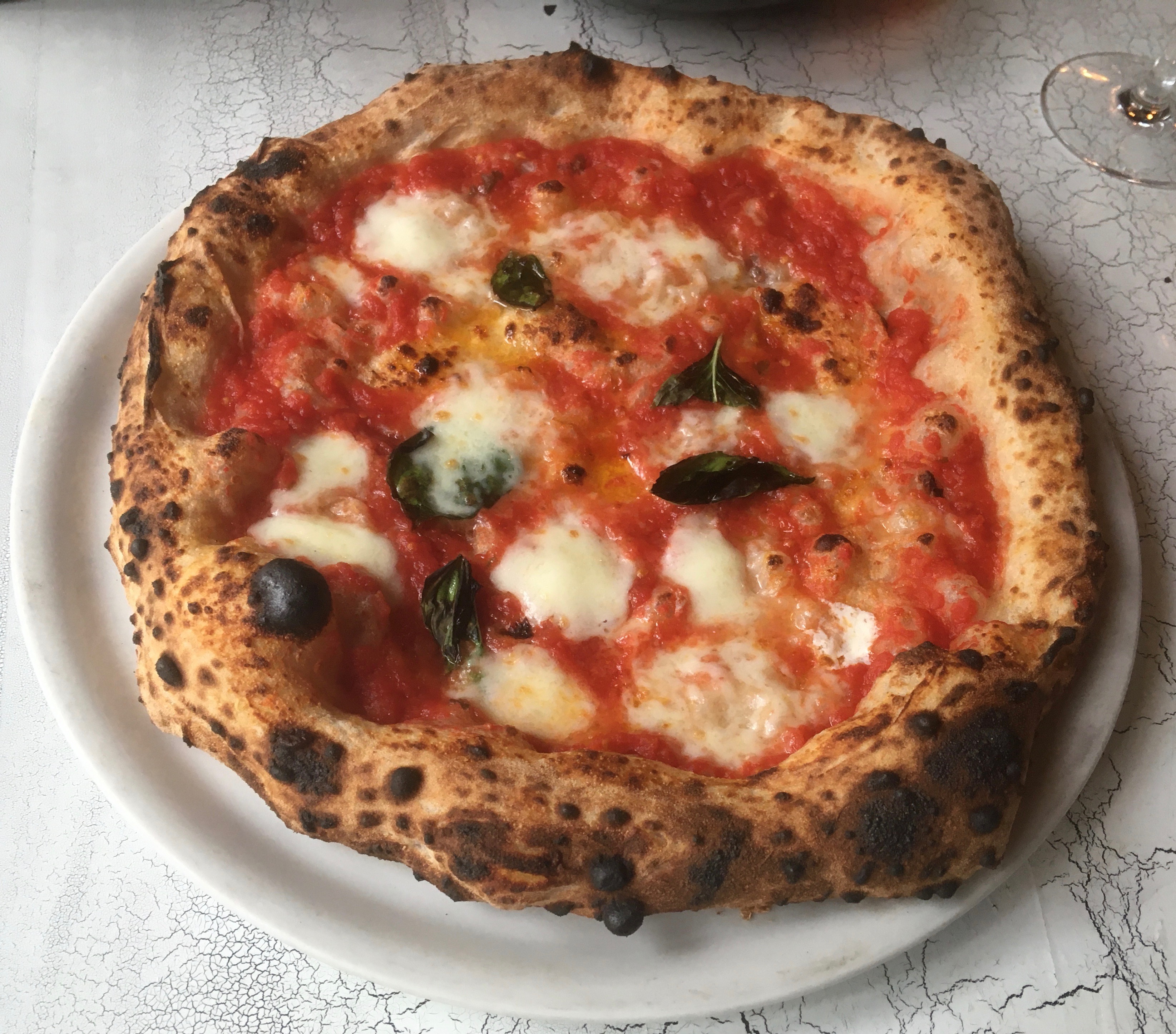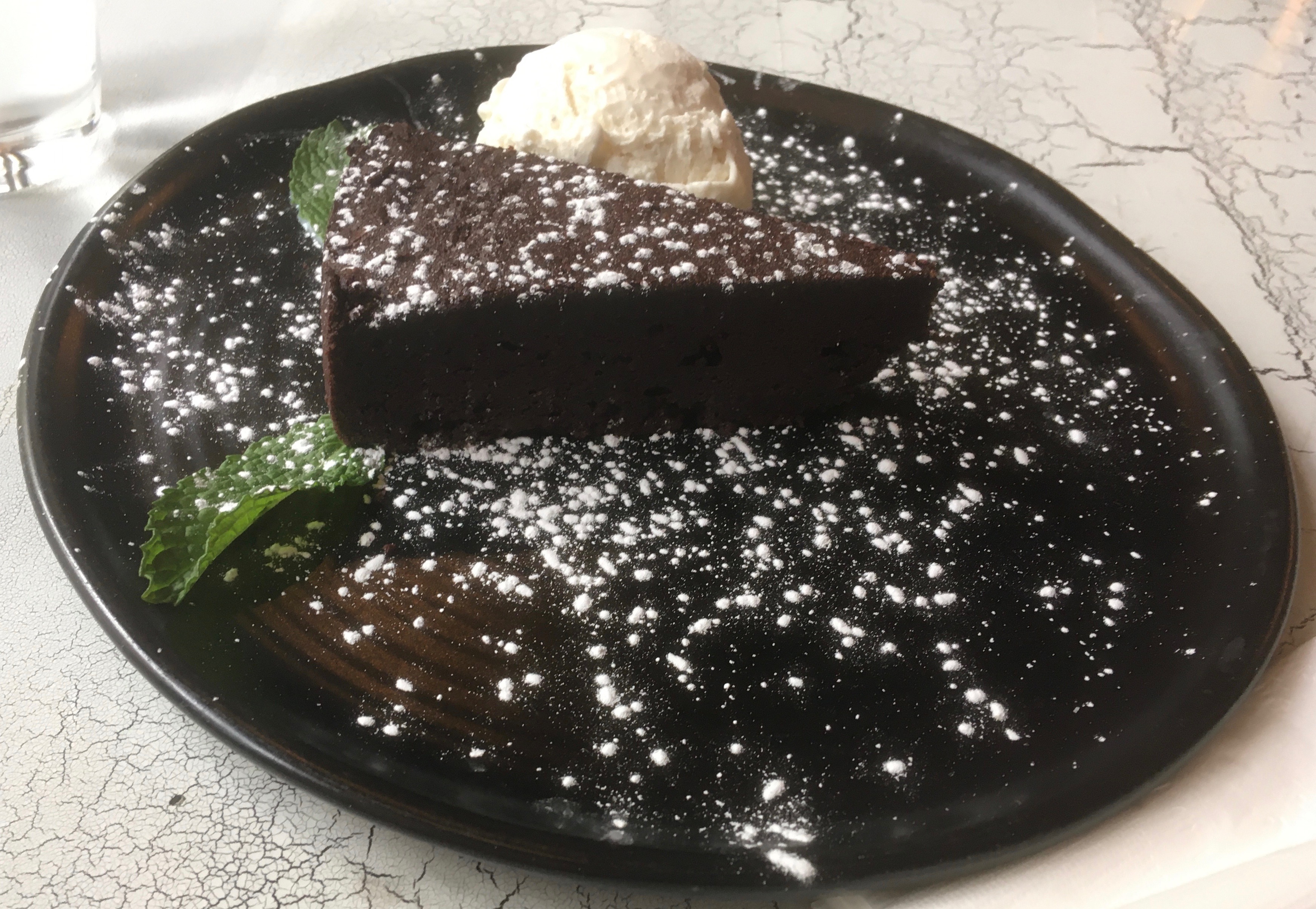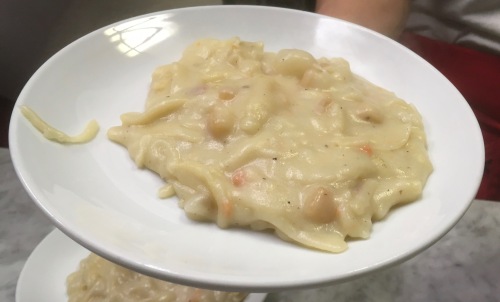“Olivier Krug, Krug Grande Cuvée and the 1996 Vintage Krug at Keste NYC,” read the email invitation from Ed “Champagne” Mc Carthy. Ed has a long history with Krug going back 50 years. It was Ed that introduced Krug to Michele and I over 40 years ago and it quickly became Michele’s favorite Champagne. We met Ed along with Olivier Krug, and Nicole Burke, Brand Manager for Moet Hennessy, at Keste’ for lunch.

Charles, Ed Mc Carthy, Olivier Krug and Roberto Caporuscio
 Krug Grande Cuvée 170 EME Edition Champagne made from 45/55% Pinot Noir, 15/20 Pinot Meunier and 25/35 Chardonnay–the percentage depends upon the vintage. The blend is made from 195 wines from 12 different vintages, the youngest from 2014 and the oldest from 1998. It is aged for seven years in the cellars. All Krug Champagnes are aged in used small oak barrels. They are all prestige cuvees made from Grand Cru and Premier Cru villages and are aged longer before release. The overall rating for the vineyards is 98% with Krug’s own vineyards rating 100%. This is a Champagne with hints of dried citrus fruit, gingerbread, hazelnuts and almonds, a note of honey and a touch of brioche. It has a long finish and a wonderful aftertaste. Fantastic! Ed looked up and said obviously this is not just another NV Champagne. $135
Krug Grande Cuvée 170 EME Edition Champagne made from 45/55% Pinot Noir, 15/20 Pinot Meunier and 25/35 Chardonnay–the percentage depends upon the vintage. The blend is made from 195 wines from 12 different vintages, the youngest from 2014 and the oldest from 1998. It is aged for seven years in the cellars. All Krug Champagnes are aged in used small oak barrels. They are all prestige cuvees made from Grand Cru and Premier Cru villages and are aged longer before release. The overall rating for the vineyards is 98% with Krug’s own vineyards rating 100%. This is a Champagne with hints of dried citrus fruit, gingerbread, hazelnuts and almonds, a note of honey and a touch of brioche. It has a long finish and a wonderful aftertaste. Fantastic! Ed looked up and said obviously this is not just another NV Champagne. $135
 Roberto Caporuscio, the owner of Keste, brought us some appetizers. First was this large burrata cheese, rolled in a batter and deep fried. To make the crust extra crispy, Roberto told us he uses gluten free flour. When we cut it open, small balls of mozzarella in cream tumbled out.
Roberto Caporuscio, the owner of Keste, brought us some appetizers. First was this large burrata cheese, rolled in a batter and deep fried. To make the crust extra crispy, Roberto told us he uses gluten free flour. When we cut it open, small balls of mozzarella in cream tumbled out.
 Calzone — Instead of the typical ricotta filling, this calzone was filled with an assortment of meats and cheeses.
Calzone — Instead of the typical ricotta filling, this calzone was filled with an assortment of meats and cheeses.
 Roberto knows we always like to start with a Pizza Margherita to share, and then we let him choose the remaining pizzas.
Roberto knows we always like to start with a Pizza Margherita to share, and then we let him choose the remaining pizzas.
 Krug 1996 made from 48% Pinot Noir, 31% Chardonnay and 21% Meunier. 1996 was one of the best vintages of the century. It was the last vintage blended by three generations of the Krug family working together. It is made from 17 different growths. This is a champagne with rich mature aromas, full ripe flavors, hints of pear, ripe fruit, citrus, honey, gingerbread, butterscotch and brioche. It has a very long finish and a memorable aftertaste. This may very well be the wine of the century. Disgorged in 2007.
Krug 1996 made from 48% Pinot Noir, 31% Chardonnay and 21% Meunier. 1996 was one of the best vintages of the century. It was the last vintage blended by three generations of the Krug family working together. It is made from 17 different growths. This is a champagne with rich mature aromas, full ripe flavors, hints of pear, ripe fruit, citrus, honey, gingerbread, butterscotch and brioche. It has a very long finish and a memorable aftertaste. This may very well be the wine of the century. Disgorged in 2007.
 Olivier Krug told us that Krug vintage celebrates the distinct character of a particular year. A Krug vintage is a blend of the most expressive wines from a single year enhanced by a stay in the cellar of over 10 years. Every Krug is different. Olivier added that “it is the music of the year catered by Krug.”
Olivier Krug told us that Krug vintage celebrates the distinct character of a particular year. A Krug vintage is a blend of the most expressive wines from a single year enhanced by a stay in the cellar of over 10 years. Every Krug is different. Olivier added that “it is the music of the year catered by Krug.”
The Krug philosophy is unique. Olivier explained that, “We take a musical approach to to Champagne creation: each plot of vines is a musician and the Cellar Master a conductor selecting those who will together preform the most generous expression of Champagne every year, Krug Grand Cuvée. Sometimes the musicians of a certain year have a unique song to play and sometimes a virtuoso soloist emerges during the auditions. Thus other Krug Champagne may also be born, making Music a natural way to reflect our craftsmanship.”
Oliver Krug told us that the 1996 vintage was a special year in Champagne. It is said to be one of the best vintages of the century and is often compared to the legendary 1928. The 1996 has special meaning for him because it was his first vintage. Also, it was the last vintage created by three generations of the Krug family working together: Paul II, Henri, Rémi, and Olivier.
 Pizza with golfetta salame and black summer truffles. Golfetta is a type of salame imported from Italy made from lean cuts of pork leg.
Pizza with golfetta salame and black summer truffles. Golfetta is a type of salame imported from Italy made from lean cuts of pork leg.

Pizza del Papa — Perfect for Fall, we ended with this pizza that Roberto named in honor of the Pope. It was topped with butternut squash puree, cheese, peppers, and zucchini.
It was a great pleasure listening to Olivier Krug speak about his Champagne and tasting these great Champagnes with him and Ed Mc Carthy

 Fried Burrata-At first I thought this was an arancini or rice ball, but Roberto told us it was a large burrata cheese, rolled in a batter and deep fried. When we cut into the crusty exterior, small balls of mozzarella in cream tumbled out.
Fried Burrata-At first I thought this was an arancini or rice ball, but Roberto told us it was a large burrata cheese, rolled in a batter and deep fried. When we cut into the crusty exterior, small balls of mozzarella in cream tumbled out. Arancini – Roberto’s rice balls (top left) are filled with fresh mozzarella and Italian roast pork.
Arancini – Roberto’s rice balls (top left) are filled with fresh mozzarella and Italian roast pork.
 Meatballs– Traditional Italian beef meatballs. Roberto said this is mother’s recipe and they were very good with a firm texture and very meaty.
Meatballs– Traditional Italian beef meatballs. Roberto said this is mother’s recipe and they were very good with a firm texture and very meaty. Cantina Federiciane Montelone di Napoli Gragnano DOC Sorrento Peninsula 2019,
Cantina Federiciane Montelone di Napoli Gragnano DOC Sorrento Peninsula 2019, Margherita – Tomato sauce, fresh mozzarella, grana, basil and extra virgin olive oil.
Margherita – Tomato sauce, fresh mozzarella, grana, basil and extra virgin olive oil. Summer Pizza– Mozzarella prosciutto, whole tomatoes, basil and extra virgin olive oil
Summer Pizza– Mozzarella prosciutto, whole tomatoes, basil and extra virgin olive oil Pizza zucchini
Pizza zucchini Tiramisu
Tiramisu Caprese – Moist flourless chocolate cake with ice cream
Caprese – Moist flourless chocolate cake with ice cream Nutella
Nutella The “Keste Mobile” now delivers all over
The “Keste Mobile” now delivers all over Roberto Caporuscio, now the sole owner of Keste Wall Street, was expecting us and made a number of special appetizers to welcome us before we had the pizza. He told us that he had been working on some new dishes during the long months on lockdown.
Roberto Caporuscio, now the sole owner of Keste Wall Street, was expecting us and made a number of special appetizers to welcome us before we had the pizza. He told us that he had been working on some new dishes during the long months on lockdown.  We began with Meatballs. Roberto told us this was his mother’s recipe and they were very good, firm textured and meaty.
We began with Meatballs. Roberto told us this was his mother’s recipe and they were very good, firm textured and meaty.  Panzerotto, a large fried pocket of dough filled with mozzarella and tomato.
Panzerotto, a large fried pocket of dough filled with mozzarella and tomato. At first I thought this was an arancini or rice ball, but Roberto told us it was a large burrata cheese, rolled in a batter and deep fried. When we cut it open, small balls of mozzarella in cream tumbled out.
At first I thought this was an arancini or rice ball, but Roberto told us it was a large burrata cheese, rolled in a batter and deep fried. When we cut it open, small balls of mozzarella in cream tumbled out. 
 Roberto’s Roman style pizza was crispy and light.
Roberto’s Roman style pizza was crispy and light. Champagne J. Lassalle Brut Premier Cru 2008 made from 60% Chardonnay and 40% Pinot Noir The average age of the vines is 50 years and the soil is clay and limestone. Grapes are crushed in a traditional wooden press. The must rests for 12 to 24 hours to allow the juice to settle. Alcoholic fermentation lasts for 8 to 10 days. Malolactic fermentation takes place to soften the acidity. The blend of grapes changes every year. Secondary fermentation is in bottle for 6 to 8 weeks. Bottles are riddled in pupîtres and adjusted a quarter turn at a time for 6 weeks. The wine is aged 10 to 11 years on the lees. It is only made in great years, current vintages are 2007 and 2008. Disgorgement: December 2017 and the dosage is 8g/l. This is an elegant silky, concentrated complex wine with subtle citrus fruit and a long finish and very pleasing after taste. It was drinking very nicely.
Champagne J. Lassalle Brut Premier Cru 2008 made from 60% Chardonnay and 40% Pinot Noir The average age of the vines is 50 years and the soil is clay and limestone. Grapes are crushed in a traditional wooden press. The must rests for 12 to 24 hours to allow the juice to settle. Alcoholic fermentation lasts for 8 to 10 days. Malolactic fermentation takes place to soften the acidity. The blend of grapes changes every year. Secondary fermentation is in bottle for 6 to 8 weeks. Bottles are riddled in pupîtres and adjusted a quarter turn at a time for 6 weeks. The wine is aged 10 to 11 years on the lees. It is only made in great years, current vintages are 2007 and 2008. Disgorgement: December 2017 and the dosage is 8g/l. This is an elegant silky, concentrated complex wine with subtle citrus fruit and a long finish and very pleasing after taste. It was drinking very nicely.
 The Padrino — Pizza with spicy soppressata, tomatoes and smoked cheese.
The Padrino — Pizza with spicy soppressata, tomatoes and smoked cheese. Pizza Montanara — the dough for this pizza is fried first, the toppings are added and then it is baked. The result is a light and crispy pie.
Pizza Montanara — the dough for this pizza is fried first, the toppings are added and then it is baked. The result is a light and crispy pie.
 La Pastiera, a traditional Springtime dessert from Napoli. This is a ricotta cheesecake made with wheat berries and orange peel.
La Pastiera, a traditional Springtime dessert from Napoli. This is a ricotta cheesecake made with wheat berries and orange peel.  Pistachio Gelato — rich and nutty.
Pistachio Gelato — rich and nutty. Caprese Chocolate cake and ice cream.
Caprese Chocolate cake and ice cream.
















































































